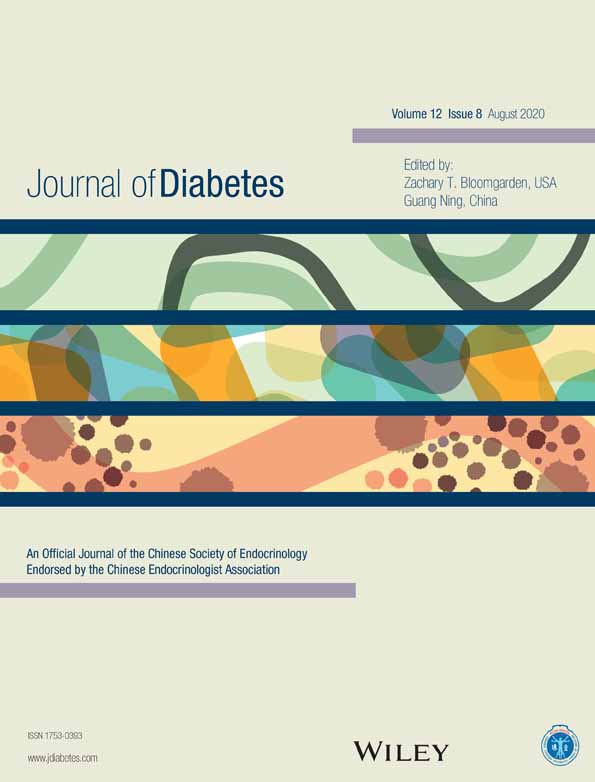Serum total bile acids associate with risk of incident type 2 diabetes and longitudinal changes in glucose-related metabolic traits
血清总胆汁酸与2型糖尿病发生风险和血糖代谢指标纵向变化的相关性研究
Wen Zhu, Shuangyuan Wang, and Huajie Dai contributed equally to this study.
Funding information: Ministry of Science and Technology of China, Grant/Award Numbers: 2018YFC1311705, 2016YFC1305600, 2016YFC1304904; National Natural Science Foundation of China, Grant/Award Numbers: 81770842, 81930021, 81941017, 21904084; Shanghai Science and Technology Commission, Grant/Award Number: YDZX20173100004881; Shanghai Outstanding Academic Leaders Plan, Grant/Award Number: 18XD1402500; Natural Science Foundation of Shanghai, Grant/Award Number: 18ZR1433100; Shanghai Shen-Kang Hospital Development Center, Grant/Award Number: SHDC12016202
Abstract
enBackground
Bile acids have been found to be related to changes in gut microbiota and multiple metabolic disorders, including type 2 diabetes (T2D). We aimed to prospectively investigate associations of serum total bile acids (TBAs) with risk of incident T2D and longitudinal changes in glycemic traits.
Methods
A community-based study was conducted at baseline in 2010, including 4968 nondiabetic participants aged ≥40 years followed up for an average of 4.3 years. Incident T2D was defined by using the 1999 WHO criteria based on 75-g oral glucose tolerance tests. Multivariate Cox proportional hazards regression was used to examine the association of serum TBAs with incident T2D. Fasting plasma glucose (FPG), 2-hour postload plasma glucose (2-h PPG), and fasting serum insulin (FSI) were measured at baseline and follow-up.
Results
During 21 653.7 person-years of follow-up, 605 cases of incident diabetes were identified (incidence rate 2.8%). Comparing to quartile 1 of serum TBAs, quartile 2, 3, and 4 were significantly associated with a 14.2%, 15.0%, and 31.4% higher risk of incident T2D (P = .029). Each one unit of log-TBAs was associated with an increase of 0.034 mmol/L in FPG, 0.111 mmol/L in 2-h PPG, 0.023 in log-FSI, and 0.012 in log-HOMA-IR (homeostasis model assessment of insulin resistance) (all P ≤ .024). The association was attenuated after further adjustment for HOMA-IR. Mediation analysis showed that insulin resistance indicated by HOMA-IR might mediate 28.5% of indirect effect on the association of TBAs with T2D (P = .0004).
Conclusions
Baseline serum TBAs were significantly associated with incident T2D and longitudinal changes in glycemic traits. Insulin resistance might partially mediate the association of TBAs and T2D.
摘要
zh背景
新近研究发现, 胆汁酸在调节肠道菌群代谢及包括2型糖尿病(Type 2 diabetes, T2D)在内的多种代谢异常中发挥重要作用。本研究旨在探讨血清总胆汁酸(Total bile acids, TBA)与T2D发生风险和血糖代谢指标纵向变化的相关性。
方法
研究选取2010年基于参加社区队列调查的4968例40岁以上的非糖尿病人群, 对其进行平均4.3年的随访。所有受试者进行75 g口服糖耐量试验(Oral glucose tolerance test, OGTT), 根据1999年WHO标准诊断新发T2D。采用Cox比例风险回归模型分析血清TBA与T2D发生风险之间的相关性。检测基线及随访时受试者空腹血糖(Fasting plasma glucose, FPG)、餐后2小时血糖(2h post-loading plasma glucose, 2h PPG)及空腹血清胰岛素(Fasting serum insulin, FSI)水平。
结果
研究人群平均21653.7人年随访, 共605例新发T2D(发病率2.8%)。与最低四分位Q1组血清TBA人群相比, Q2、Q3及Q4组人群的T2D发生风险分别增加14.2%, 15.0%及31.4 %(趋势p =0.029)。Log TBA每增加1个单位, FPG水平增高0.034 mmol/L, 2h-PPG水平增高0.111 mmol/L, log FSI水平增高0.023, log HOMA-IR水平增高0.012(p均 ≤ .024)。进一步校正基线HOMA-IR水平后, 血清TBA与T2D发生风险之间的相关性减弱。中介分析结果显示, 28.5%的TBA与T2D发生风险之间的间接作用由HOMA-IR胰岛素抵抗指数介导 (p = .0004)。
结论
基线血清TBA水平与T2D发生风险及血糖代谢指标纵向变化呈显著正相关。胰岛素抵抗可能部分介导了TBA和T2D之间的相关性。
CONFLICT OF INTEREST
The authors declare no conflict of interest.




